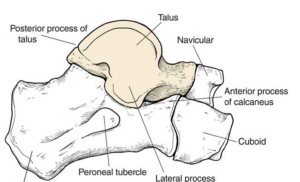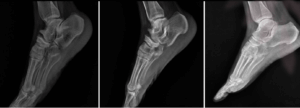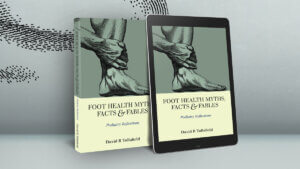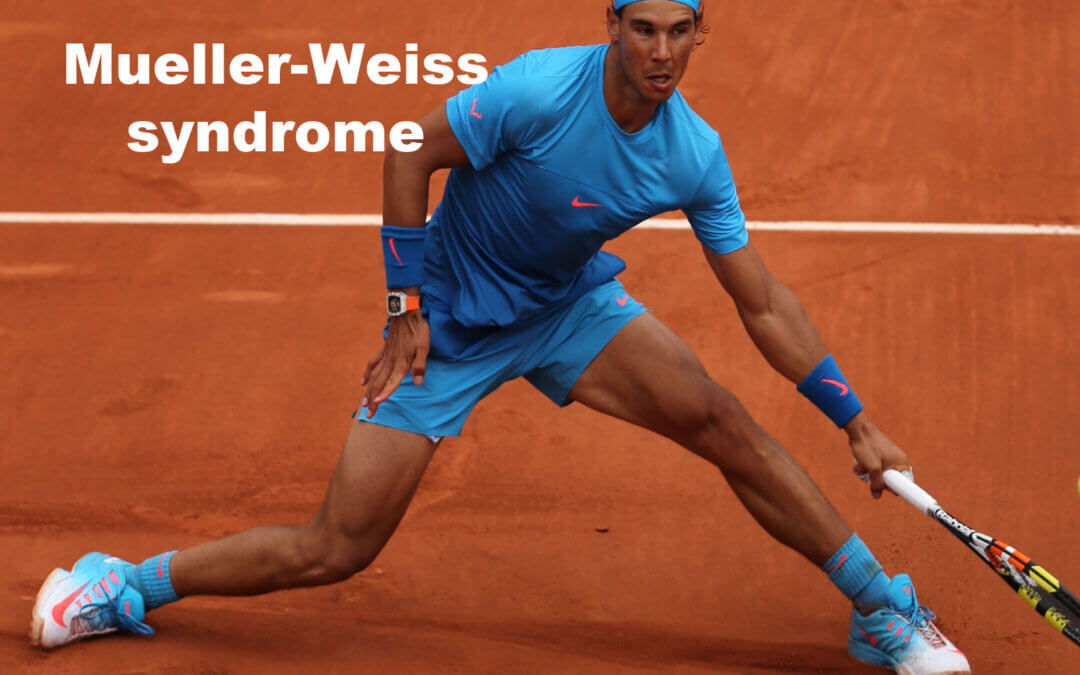Mueller-Weiss syndrome
Here we are, another tennis player who has been suffering for a long time with foot pain. Rafael Nadal – one of the world’s most successful players. But, aged 36 – sometimes considered the peak age of most men, the Spanish athlete known as ‘King of the Clay’ is on borrowed time. What are his chances of a come back? You don’t have to be a professional to read this article.
I wrote ‘know your limitations’ in January 2021, pointing out the problem of not respecting injury to your own body. My recent article about Emma Radicanu, our British hopeful is another example of trauma tennis players have to tolerate as much as dancers do. DO play sports, but know that it can have consequences. These consequences will last into your future days on this mortal earth.

The TALUS shown side on showing its curved top surface allowing main ankle movement
A quick refresher on the anatomy is worth a link to my other article on this site – The Third Ankle Joint. This will allow you to see why everyone should know how vulnerable the joint and bone is. The talus links with the navicular and while you cannot see the shape as it sits in the basin of the navicular bound, the head is rounded. Later on the condition called osteonecrosis causes changes in the shape, which are better seen on the x-rays below.
The Condition
Anyone can google his foot pain to find it is called Mueller-Weiss syndrome. This is a condition where the central ankle bone called the talus is affected in adulthood and degenerates because the blood supply has been affected. The bone collapses and is referred to as osteonecrosis – or death of bone. Unfortunately, the talus does not have a good blood supply in the first place, and although, for the most part, few suffer from damage as the structure is so well designed and protected, collapse, as shown in the x-rays, means the link between foot and leg are in danger of being affected.

Right to left: Right foot shows early degeneration of the talus, progression with bone distortion (peak projection), left joint no longer normal shape. (Lynser, 2021)
I have simplified the statement below taken from a paper [2] by Mayich to make it a little more comprehensive with a few link words.
“Mueller-Weiss disease involves dorsolateral fragmentation and collapse of the navicular and leads to functional misalignment and painful deformities. In cases where operative management is indicated, planning a graft surgery optimises the healing potential. However, there is considerable variability in the anatomy and no single strategy is likely the ‘correct’ method. Furthermore, supporting literature remains sparse, and if postoperative complications can be avoided, improvements in function can be anticipated.”
For you or I, who are low key in our activity, relative to athletes in peak condition, this condition may settle and you can live with the condition adequately. However, the types of forces Nadal creates with tennis foot and ankle contact on the court are akin to the problems beset by Andy Murray with his hip joint. Murray’s hip was more amenable to surgery than Nadal’s foot will be. The reason athletes can push themselves is their competitive streak, motivation, and extreme fitness, long training and ethics to be better than everyone else – this allows them to compensate for the type of problems the regular person would give up on a long time ago. Look at the extreme pronation of the right ankle, subtalar and midfoot joint in the feature picture of Nadal. The left foot, the foot affected, shows the extreme opposite movement.
Prediction of his future
An article suggesting that his foot injury threatens his career is no idle concern because foot collapse, i.e. flattening of his foot, will follow and the midfoot will develop arthritis requiring salvage surgery. No prosthetic implant has been commercially produced to replace this essential bone, unlike the hip. The bone articulates with several other bones and because of this, we find the third ankle joint plays a part in converting leg movement into healthy foot movement.

He has used anti-inflammatory medicines, which are not ideal long-term and mask an injury. Radiofrequency therapy has been used and definitely can work, but there are provisos. First, you have to change your activity to limit further damage. Healing and resolution must be allowed to take place. Forced activity and activity encountered with tremendous forces of movement will cause failure of treatment. This is the dilemma all athletes face. Keep going until you can’t go any longer. Then you have to live with the consequences.
Surgery
Surgery will be offered in two forms—bone replacement to stimulate growth and shape. A piece of bone inserted into the talus could help generate some improvement. The best bone graft comes from the individual and the best site is the top of the pelvis with a rich bone quality. However, this form of treatment would mean no more championship tennis for Nadal at a world-class competitive level as it would not last without masking him with support and pain killers. The more damage he does, his timeline will run out and his foot will be permanently damaged and painful. As a former foot surgeon who has operated on the talus, I cannot imagine what we would write on the consent form to ensure any joint agreement could be reached. In truth, it would be the bravest of surgeons, not that there aren’t plenty around. Fix Nadal become famous. Screw his foot up, well …!
His long term prospects. My prediction would be his performance would drop. Peak age and challenge to reverse the damage that has been present since 2005 allegedly gives him a low chance of recovery. He will, in all probability, have his foot fused in the midfoot, the second surgical choice, but with a bone graft. Doubtless, he needs to consider his time left at the net and turning his skills to training new players who doubtless will injure themselves along the way. I guess that’s why they get the big $$$$$.
Sorry, Rafael, your card has been marked…
![]()
[1] Joseph VM, Lynser D, Khan AY, Daniala C. Mueller Weiss syndrome, a less elucidated and unusual cause of midfoot pain: A case report. Indian J Musculoskelet Radiol 2021;3:94-7.
[2] Mayich, D. Joshua The Treatment of Mueller-Weiss Disease: A Systematic Approach. Techniques in Foot & Ankle Surgery: June 2016 – Volume 15 – Issue 2 – p 59-73 doi: 10.1097/BTF.0000000000000088. Accessed 6/6/22
David R Tollafield is a former foot surgeon and podiatrist specialising in joint pain management of the foot
Sign-up for here my regular FREE newsfeed
Why not read – Podiatry as a career choice? on ConsultingFootPain

You can now read Foot Health Myths Facts & Fables by David R Tollafield published at Amazon books
Published by Busypencilcase Communications Est. 2015 for ConsultingFootPain



Recent Comments